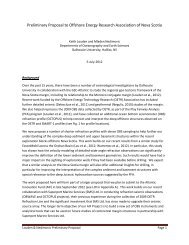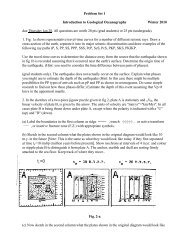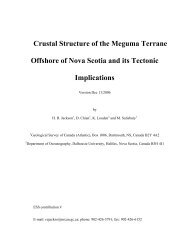the stratigraphy and structural history of the mesozoic and cenozoic ...
the stratigraphy and structural history of the mesozoic and cenozoic ...
the stratigraphy and structural history of the mesozoic and cenozoic ...
You also want an ePaper? Increase the reach of your titles
YUMPU automatically turns print PDFs into web optimized ePapers that Google loves.
Abstract<br />
The continental shelf <strong>and</strong> slope <strong>of</strong> Nova Scotia is underlain by a number <strong>of</strong><br />
interconnected rift sub-basins that collectively form <strong>the</strong> Scotian Basin. Petroleum<br />
exploration companies have been moderately successful on <strong>the</strong> shelf region <strong>of</strong> <strong>the</strong> basin,<br />
close to Sable Isl<strong>and</strong>, where several significant hydrocarbon discoveries have lead to <strong>the</strong><br />
development <strong>of</strong> <strong>the</strong> Sable Project. This success has sparked interest in exploration <strong>of</strong> <strong>the</strong><br />
adjacent frontier slope region within water depths between 200 <strong>and</strong> 2500m. However, <strong>the</strong><br />
Scotian Slope Basin has been <strong>the</strong> focus <strong>of</strong> only limited regional geologic studies. Present<br />
accounts <strong>of</strong> <strong>the</strong> slope are largely extrapolated from shelf descriptions <strong>and</strong>/or modeled<br />
after play types <strong>and</strong> depositional systems typically associated with deep water exploration<br />
in o<strong>the</strong>r Atlantic margin areas. A discrete study area was defined for this project within<br />
<strong>the</strong> central slope region approximately 125 kilometres southwest <strong>of</strong> Sable Isl<strong>and</strong>. The<br />
area is approximately 120 square kilometres <strong>and</strong> contains five <strong>of</strong> <strong>the</strong> ten Scotian Slope<br />
exploration wells, three shelf wells <strong>and</strong> 4 500 kilometres <strong>of</strong> 2D seismic data.<br />
Scotian Basin development commenced in <strong>the</strong> Late Triassic - Early Jurassic with<br />
rifting <strong>of</strong> <strong>the</strong> Pangean Supercontinent <strong>and</strong> opening <strong>of</strong> <strong>the</strong> Atlantic Ocean. Red bed <strong>and</strong><br />
evaporate deposition characterized <strong>the</strong> rift phase, while <strong>the</strong> drift phase was characterized<br />
by clastic progradational with periods <strong>of</strong> carbonate deposition. A prominent carbonate<br />
bank developed in <strong>the</strong> western part <strong>of</strong> <strong>the</strong> basin during <strong>the</strong> Late Jurassic, <strong>the</strong> eastern<br />
extent <strong>of</strong> which was limited by a Late Jurassic - Early Cretaceous Sable Delta. As relative<br />
sea level rose throughout <strong>the</strong> Late Cretaceous <strong>and</strong> Tertiary major transgressive sequences<br />
were deposited. This overall transgression was punctuated by major sea level drops<br />
resulting in <strong>the</strong> deposition <strong>of</strong> regressive lowst<strong>and</strong> sequences partially comprising turbidite<br />
deposits.<br />
Seismic stratigraphic analysis <strong>of</strong> <strong>the</strong> study area identified ten major sequence<br />
boundaries on <strong>the</strong> basis <strong>of</strong> reflection character <strong>and</strong> termination patterns. The sequence<br />
boundaries divide <strong>the</strong> Mesozoic through Cenozoic Scotian Slope Basin fill into nine<br />
depositional sequences. There are major changes in depositional style <strong>and</strong> thickness<br />
distribution patterns <strong>of</strong> <strong>the</strong> depositional sequence through time. Depositional patterns are<br />
closely linked to <strong>the</strong> tectonic, <strong>structural</strong> <strong>and</strong> halotectonic evolution <strong>of</strong> <strong>the</strong> basin.<br />
Five fault families were defined within <strong>the</strong> study on <strong>the</strong> basis <strong>of</strong> <strong>the</strong>ir regionality,<br />
duration <strong>of</strong> movement <strong>and</strong> depths <strong>of</strong> detachment; <strong>the</strong> Slope Basin-Bounding Fault<br />
Family, <strong>the</strong> Basement-Involved Fault Family, <strong>the</strong> Listric Growth Fault Family, <strong>the</strong> Major<br />
<strong>and</strong> Minor Sedimentary Fault Family <strong>and</strong> <strong>the</strong> Halokinetically Induced Fault Family. The<br />
existence <strong>of</strong> a sixth fault family, <strong>the</strong> Transfer Fault Family, is implied by local <strong>structural</strong><br />
<strong>and</strong> stratigraphic architecture, however, <strong>the</strong> signature <strong>of</strong> this potential transfer fault is not<br />
clear enough on <strong>the</strong> available seismic data to allow for confident mapping.<br />
The complete spectrum <strong>of</strong> salt structures typical <strong>of</strong> passive margins has been<br />
identified <strong>and</strong> mapped within <strong>the</strong> study area. Five halotectonic <strong>structural</strong> associations<br />
with variable areal distributions have been identified. These associations are: <strong>the</strong> Trough<br />
<strong>and</strong> Swell Association, <strong>the</strong> Intra-Salt Detachment Association, <strong>the</strong> Diapiric Association,<br />
<strong>the</strong> Secondary Weld Association, <strong>and</strong> <strong>the</strong> Allochthonous Salt Association.<br />
ii









